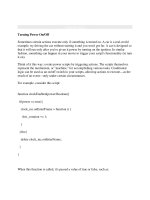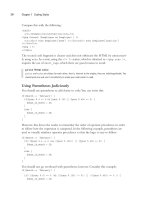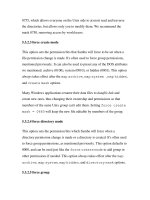U-02 ADVANCED: EYE ON MELISSA doc
Bạn đang xem bản rút gọn của tài liệu. Xem và tải ngay bản đầy đủ của tài liệu tại đây (1.27 MB, 12 trang )
ON MELISSA
Brenda Hoddinott
U-02 ADVANCED: EYE ON MELISSA
In this project, you draw an eye, with a
focus on correctly rendering the
structures of the anatomical forms
surrounding the orbital cavity.
You add shading in layers by working from light to dark, while rendering a highly detailed
human eye with a combination of three graduated shading techniques - hatching, crosshatching,
and squirkling.
Eyes are the most expressive facial feature. The shapes and sizes of people’s eyes can help
identify their gender, age, and cultural origin. In a portrait, the eyes alone can often identify who
the person is. The eye in this project belongs to a beautiful young lady named Melissa, who is the
daughter of my friend Crystal Basta.
This lesson is divided into four sections:
STRUCTURAL INSIGHTS INTO EYES: In order to understand how to draw an eye
correctly, you need to be aware of its basic construction behind the small section you can see.
KEEPING AN EYE ON PROPORTIONS: You sketch the various parts of the eye
proportionately correct.
ADDING LIGHT AND MIDDLE VALUES: Hatching and crosshatching graduations
bring out the three-dimensional forms of the skull around the eye. You also lay down light
and medium values to enhance the forms of the fleshy sections around the eye.
DARK VALUES AND FINAL DETAILS: You add dark values to provide more contrast
to the facial forms, and then add the final details such as eyelashes.
Suggested drawing supplies for this project include: good quality white drawing paper, graphite
pencils, kneaded and vinyl erasers, pencil sharpener, and a sandpaper block.
12 PAGES – 15 ILLUSTRATIONS
Recommended for artists from age 12 to adult with good drawing skills, and fine art educators in
home school, academic and recreational environments.
Published by Hoddinott Fine Art Publishers, Halifax, NS, Canada – 2005 (Revised 2006)
Copyright to all articles, images, text, projects, lessons and exercises within this drawing class belong to Brenda Hoddinott and may
not be reproduced or used for any commercial purposes whatsoever without the written permission of Brenda Hoddinott.
E-mail Web sites and
2
STRUCTURAL INSIGHTS INTO EYES
Eyes are the most expressive feature. The shapes and sizes of people’s eyes can help identify
their gender, age, and cultural origin. Eyes alone can often identify who the person is.
ILLUSTRATION 02-01
Check out lesson P-05 Intermediate: Eyelashes on an
Eye! A frontal view of an eye, with a focus on
correctly rendering eyelashes, provides a completely
different perspective on drawing a highly realistic
human eye.
In order to understand how to draw an eye correctly, you need to be aware of its basic
construction behind the small section you can see. The iris and pupil take up most of the visible
section of an eye, with only a little of the whites showing. The largest section of the eyeball is
hiding inside the orbital socket in the frontal section of the skull.
Copyright to all articles, images, text, projects, lessons and exercises within this drawing class belong to Brenda Hoddinott and may
not be reproduced or used for any commercial purposes whatsoever without the written permission of Brenda Hoddinott.
E-mail Web sites and
3
I use very simple names to identify each part of an eye, and the facial anatomy surrounding it.
Refer to the next drawing and find each of the following.
1. The arch-shaped group of hairs, above the eye, is known as an eyebrow.
2. A fold in the skin, above the eye is called an upper eyelid crease.
3. The upper eyelid is a movable fold of skin that opens and closes to protect the eyeball.
4. A small triangular shape in the inside corner of the eye, is called the inner corner.
5. The white of the eye (the visible section of the eyeball) is light, but not really white.
6. A highlight is the brightest area where light bounces off the surface of the eye.
7. Eyelashes are fine hairs that grow from the outer edges of the upper and lower eyelids.
8. The pupil of an eye is the darkest circular shape within the iris.
9. The iris is the colored circular section of the eyeball surrounding the pupil.
10. The lower eyelid is a fold of skin protecting the lower section of the eyeball.
ILLUSTRATION 02-02
KEEPING AN EYE ON PROPORTIONS
In this section, you sketch the various parts of the eye proportionately correct. Suggested
drawing supplies for this project include: good quality white drawing paper, graphite pencils,
kneaded and vinyl erasers, pencil sharpener, and a sandpaper block.
Copyright to all articles, images, text, projects, lessons and exercises within this drawing class belong to Brenda Hoddinott and may
not be reproduced or used for any commercial purposes whatsoever without the written permission of Brenda Hoddinott.
E-mail Web sites and
4
1) Use an HB pencil to lightly sketch a circle as the outline of Melissa’s eyeball.
Drawing a circle freehand becomes quite simple when you’ve devoted lots of time to
practicing this skill. Try rotating your paper and looking at your drawing from different
perspectives. This little trick often allows you insight into the problem areas. Looking at
the reflection of your circle in a mirror will also help you to see areas in need of fixing.
2) Sketch another circle (the iris) positioned inside and slightly toward the upper right of
the eyeball.
ILLUSTRATION 02-03 ILLUSTRATION 02-04
3) Sketch a curved line (the edge of the upper eyelid) through and across the eyeball and
iris.
4) Add another curved line to mark the edge of the lower eyelid.
ILLUSTRATION 02-05 ILLUSTRATION 02-06
Copyright to all articles, images, text, projects, lessons and exercises within this drawing class belong to Brenda Hoddinott and may
not be reproduced or used for any commercial purposes whatsoever without the written permission of Brenda Hoddinott.
E-mail Web sites and
5
ILLUSTRATION 02-07
5) Sketch another circular
shape inside the iris as
the pupil.
Take note that a tiny
section of the pupil is
above the line that marks
the edge of the upper
eyelid.
Whenever you draw
eyes, keep the initial
sketch lines very light
so they can be erased
later. No part of an eye
should be drawn with
dark bold lines.
ILLUSTRATION 02-08
6) Lightly
sketch the
edge of the
face.
The upper
(slightly curved)
line identifies
the form of the
upper bone
structure
surrounding the
orbital socket.
7) Use your kneaded
eraser to lighten
(or erase) the
original sketch
lines above and
below the eye.
Copyright to all articles, images, text, projects, lessons and exercises within this drawing class belong to Brenda Hoddinott and may
not be reproduced or used for any commercial purposes whatsoever without the written permission of Brenda Hoddinott.
E-mail Web sites and
6
ILLUSTRATION 02-09
8) Lightly sketch
a few lines to
mark the
location of the
eyebrow.
9) Add another line
around the outer
edge of the lower
eyelid and the small
visible section of the
upper eyelid (on the
left) to represent the
thickness of the flesh
of the eyelids.
10) Sketch a small
horizontal comma-
shape below the inner
corner of the eye.
ILLUSTRATION 02-10
11) Add two
small
circular
shapes as
the
highlights.
12) Lightly sketch a
horizontal oval-
shape above the
inner corner of
the eye.
While some of these
shapes may currently
seem out of place, they
will be used to help
map the shading, as you
will see in the next
section.
Before you continue, check
over your sketch to make
sure nothing is left out.
Copyright to all articles, images, text, projects, lessons and exercises within this drawing class belong to Brenda Hoddinott and may
not be reproduced or used for any commercial purposes whatsoever without the written permission of Brenda Hoddinott.
E-mail Web sites and
7
ADDING LIGHT AND MIDDLE VALUES
In this section you use hatching and crosshatching graduations to bring out the three-dimensional
forms of the skull around the eye. You also lay down the light and medium values to enhance the
forms of the fleshy sections around the eye, and add shading to the iris.
13) Add shading to the facial areas around the eye, the white of the eye, the upper and
lower eyelids, the iris, and the inner corner of the eye.
Use 2H and HB pencils and hatching graduations to visually separate the various parts of
the eye. Take note of how all the hatching lines are curved to follow the perceived contours
of the facial forms. The small shapes above and below the inner corner of the eye (added in
the last section) are left white for now, and will remain very light in value. A few tiny lines
radiate outward from the perimeter of the pupil onto the iris.
ILLUSTRATION 02-11
You can indicate the color of the iris of an eye, by using different
values. Brown eyes are very dark in value, almost as dark as the pupil.
Hazel, blue, or green eyes are mostly shaded with middle values. Pale
blue, green, or gray eyes are very light in value and contrast sharply to
the dark pupil.
Copyright to all articles, images, text, projects, lessons and exercises within this drawing class belong to Brenda Hoddinott and may
not be reproduced or used for any commercial purposes whatsoever without the written permission of Brenda Hoddinott.
E-mail Web sites and
8
You can make the transition from one value to the next barely
noticeable, by drawing the individual lines of your hatching and
crosshatching in different lengths. Sometimes a short line, placed inside
a space between two other lines, helps make the transition look
smoother.
14) Layer some darker sections of shading over the hatching lines with crosshatching.
Your goal in this step is to further bring out the three-dimensional forms by using a full
range of values from very light to almost black.
Most artists prefer to work from light to dark. By drawing your light values first, you can
then layer your medium shading on top of your light shading. This layering creates a nice
smooth transition between different values. The darkest values are then built in layers on
top of the medium values.
Continue using 2H and HB pencils and pay attention to the sections that have curved
crosshatching lines. The values automatically become darker with the addition of the
crosshatching. Be careful to leave lots of lighter sections.
ILLUSTRATION 02-12
Copyright to all articles, images, text, projects, lessons and exercises within this drawing class belong to Brenda Hoddinott and may
not be reproduced or used for any commercial purposes whatsoever without the written permission of Brenda Hoddinott.
E-mail Web sites and
9
For crosshatching, I personally prefer to turn my drawing paper (or
sketchbook) around in various directions as I draw, so that I am always
using my natural hand motion (mine is from the lower left toward the
upper right). You may also wish to try holding your arm in different
positions as you draw.
15) Add medium values to further enhance the various forms around the eye.
Use HB and 2B pencils and keep the tips freshly sharpened with either a pencil sharpener
or sandpaper block. Don’t rush! Take your time and slowly build the values steadily darker
where needed. Pay close attention to which sections need to be left lighter. A strong
contrast in different values creates the lifelike illusion of a three dimensional reality.
16) Add darker values in the shadow sections of the iris and white of the eye.
I’ve used squirkles to shade some darker sections of the iris, such as around the perimeter
and under the upper eyelid which is in shadow.
ILLUSTRATION 02-13
Copyright to all articles, images, text, projects, lessons and exercises within this drawing class belong to Brenda Hoddinott and may
not be reproduced or used for any commercial purposes whatsoever without the written permission of Brenda Hoddinott.
E-mail Web sites and
10
DARK VALUES AND FINAL DETAILS
In this section, you add dark values to provide more contrast to the facial forms and then add the
final details such as eyelashes.
17) With a 2B pencil add dark shading to the areas that are in shadow, such as the inner
and outer corners of the eye.
18) Use freshly sharpened HB and 2B pencils to draw the details of the eyebrows.
19) Add shading to the pupil with 4B and 6B pencils, leaving the highlights white.
ILLUSTRATION 02-14
20) Use an HB pencil to draw only half as many eyelashes as you think there should be.
Eyelashes are rendered with thin curved lines of different lengths, are unevenly spaced, and
appear thicker closer to the eyelids. They grow from the outer edges of the upper and lower
eyelids (not the whites of the eye), and are drawn in groups rather than several single
lashes.
Copyright to all articles, images, text, projects, lessons and exercises within this drawing class belong to Brenda Hoddinott and may
not be reproduced or used for any commercial purposes whatsoever without the written permission of Brenda Hoddinott.
E-mail Web sites and
11
Always draw eyelashes in the direction in which they grow, from the eyelid outward.
Begin at the base of the eyelash and press firmly with your pencil. Slowly release the
pressure you apply as your curved line extends toward the tip. Gently lift your pencil from
the paper when the tip of the line is very thin and light in value.
21) Add some faint thin lines extending onto the whites from the corners of the eye to look
like tiny blood vessels.
22) Check over the shading and touch up any sections where the graduations do not flow
smoothly into one another.
To make areas lighter mold your kneaded eraser to a wedge, and gently and selectively pat
the shading lines. To make a section darker, simply add more thin crosshatching lines in
between others.
ILLUSTRATION 02-15
Copyright to all articles, images, text, projects, lessons and exercises within this drawing class belong to Brenda Hoddinott and may
not be reproduced or used for any commercial purposes whatsoever without the written permission of Brenda Hoddinott.
E-mail Web sites and
12
BRENDA HODDINOTT - BIOGRAPHY
As a self-educated teacher, visual artist, portraitist, forensic artist, and illustrator, Brenda
Hoddinott utilizes diverse art media including graphite, technical pen, colored pencil, chalk
pastel, charcoal, conté crayon, and oil paints.
My philosophy on teaching art is to focus primarily on the enjoyment
aspects while gently introducing the technical and academic. Hence,
in creating a passion for the subject matter, the quest for knowledge
also becomes enjoyable.
>Brenda Hoddinott<
Born in St. John’s, Newfoundland, Brenda grew up in the small town of Corner Brook. She
developed strong technical competencies with a personal commitment to self directed learning,
and the aid of assorted “Learn to Draw” books. During Brenda’s twenty-five year career as a
self-educated civilian forensic artist, numerous criminal investigation departments have
employed Brenda’s skills, including Royal Canadian Mounted Police and municipal police
departments. In 1992, Brenda was honored with a commendation from the Royal Canadian
Mounted Police, and in 1994, she was awarded a Certificate of Membership from “Forensic
Artists International”.
Her home-based art career included graphic design, and teaching recreational drawing and
painting classes. As supervisor of her community’s recreational art department, Brenda hired and
trained teachers, and designed curriculum for several children’s art programs. In 1998, Brenda
chose to end her eighteen-year career as an art educator in order to devote more time to writing,
drawing, painting, and developing her websites.
Drawspace incorporates her unique style and innovative approach to
curriculum development. This site offers downloadable and printable drawing classes for
students of all abilities from the age of eight through adult. Students of all ages, levels and
abilities have praised the simple step-by-step instructional approach. These sites are respected as
a resource for fine art educators, home schooling programs, and educational facilities throughout
the world.
LEARN-TO-DRAW BOOKS BY BRENDA HODDINOTT
Drawing for Dummies: Wiley Publishing, Inc., New, York, NY, this 336 page book is available
on various websites and in major bookstores internationally.
The Complete Idiot’s Guide to Drawing People: Winner of the Alpha-Penguin Book of the
Year Award 2004, Alpha - Pearson Education – Macmillan, Indianapolis, IN, this 360 page book
is available on various websites and in major bookstores internationally.









